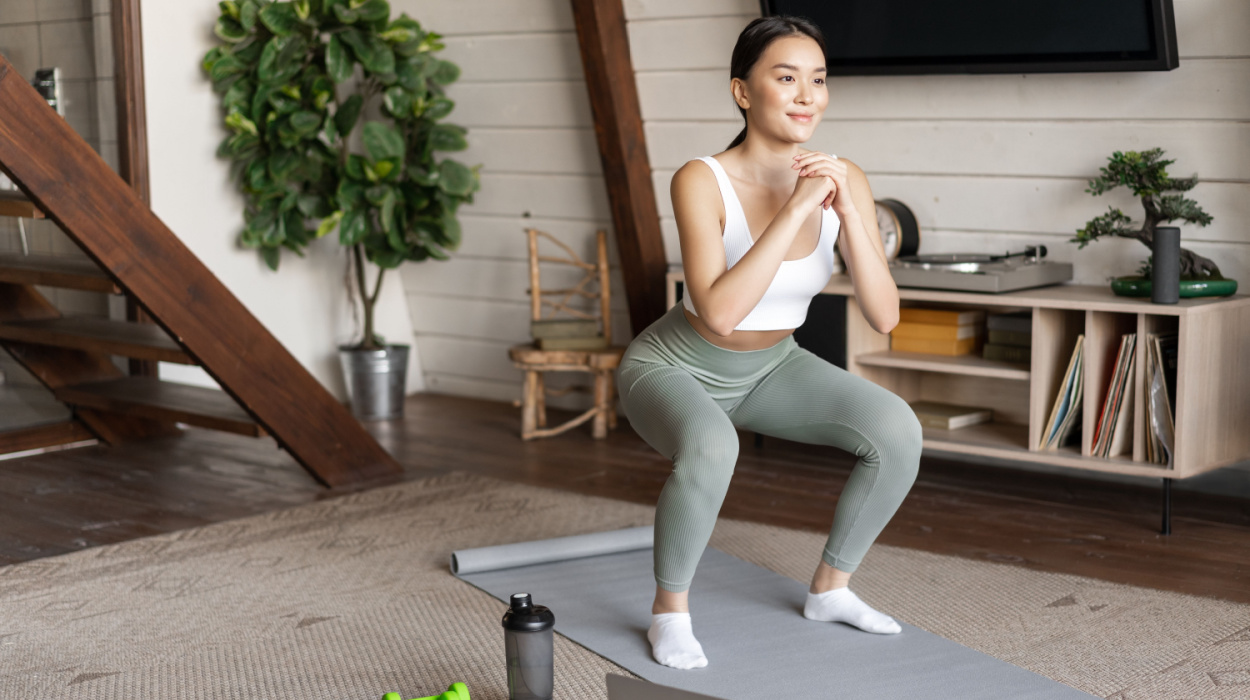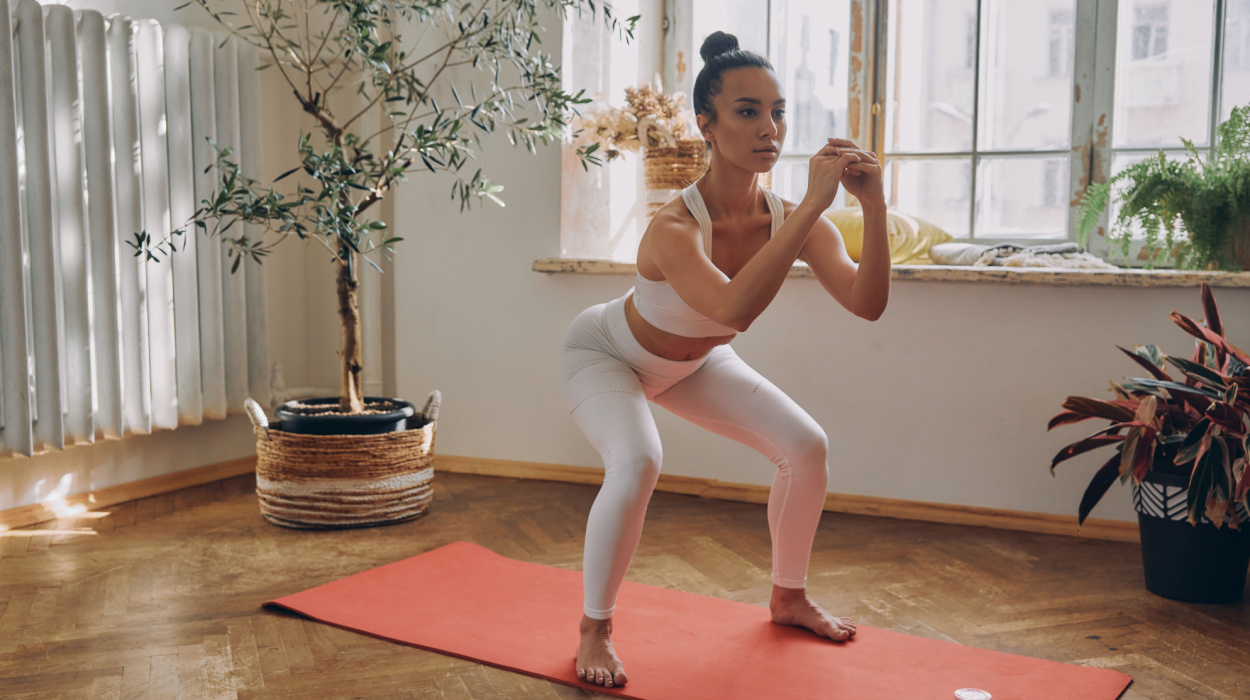Squats are often dubbed the king of lower body exercises. As part of a balanced strength training routine, this exercise offers many benefits for those with weight loss goals. It can help burn calories, build lean muscle, and ultimately, lose body fat.
Performing squats also has functional benefits, helping you move more easily throughout your daily life. There are many squat variations, including the air squat, sumo squat, jump squat, and more. Thus, if you get bored, you have options.
But how many squats a day can foster fat loss? This article digs into how many squats a day to lose belly fat, the health benefits of squatting, and more. Let’s get to it.
How Many Squats A Day Should People Do To Lose Belly Fat?
How many squats a day to lose belly fat depends on many factors, including one’s goals, fitness level, current weight, and more. However, squats can contribute to overall reduced body fat when incorporated as part of a holistic exercise routine alongside a healthy diet. In fact, squats are a great exercise with multiple health benefits, such as increased muscle mass, improved functional movement, enhanced bone health, improved brain health, and enhanced flexibility.
How Many Squats Per Day To Lose Belly Fat?

Are you wondering, how many squats a day should I do? Well, the truth is that the exact number of squats per day to burn belly and body fat depends on various factors.
It’s important to consider individual body weight, diet, fitness level, and goals, which will determine how many squats a day to see results.
It’s also important to note that total body fat must be lost to burn body fat, and there is no way to target belly fat specifically.
However, one scientific review suggests squat exercises burn[1] between 11 to 18 calories per minute. So, what does this mean?
Most experts estimate that one pound is worth about 3500 calories. This would equate to about 194 to 311 squats. However, performing this many squats in a row could lead to injury, especially for those with lower fitness levels.
Instead, your exercise regime should incorporate various weightlifting movements to foster muscle growth and promote fat loss. For instance, well-rounded weightlifting workouts may include squats, deadlifts, bench presses, lunges, abdominal exercises, and upper body exercises.
Working with a certified personal trainer may also help you develop proper technique, avoid injury, and achieve your goals.
Do Squats Burn Belly Fat?
Squats can be part of a balanced workout routine, which may eventually help burn belly fat. As stated above, it’s impossible to target belly fat; instead, this comes down to total body fat loss.
This exercise, in particular, can be a great fat-burning option since it targets the major muscles in the legs, the core, and the supporting muscles in the back. This not only burns major calories but also leads to the development of lean muscle.
At the same time, sustainable weight loss comes down to permanent lifestyle changes, such as a healthy diet, managing stress, and a regular exercise routine. Be cautious when relying on supplements, fat burners, or diet pills. There is no quick fix for healthy and sustainable weight loss and usually, it takes a slow and steady approach.
Health Benefits Of Squatting

Squats aren’t just about losing belly fat. So, with that in mind, here are the top health benefits of squatting that you should know.
Increases Lean Muscle Mass
Squats are a strength training exercise that works the lower body muscles, including the glutes, hamstrings, quadriceps, and core muscles. This movement targets multiple muscle groups, making it a very effective weightlifting exercise.
Weightlifting, or strength training, is associated with increased lean muscle mass.[2]
This is mainly due to the stress it places on the body. When the body perceives stress, it adapts accordingly. In this case, it adapts by increasing muscle mass.
Burns Calories
To lose weight, the calories burned[3] must be more than the calories consumed. This places the body in a caloric deficit, which will contribute to weight loss. Luckily, squats can help burn significant calories, contributing to this deficit and your goals.
Additionally, the muscle mass created through squats can help you burn more calories at rest, which may further your weight loss efforts.
Improves Functional Movement
Squats are one of the most primal and critical functional movements,[4] reducing the risk of injury, enhancing performance, and supporting physical activity at any age.
Unsurprisingly, we perform many squats throughout our daily activities. For example, we squat down to pick up items on the floor, to lift heavy objects, and to get out of a chair.
By practicing this movement, we can become stronger and move more effortlessly in our everyday lives. This might also mean we face less pain or injury when performing everyday activities.
Builds Strong Bones
Research shows that many squat variations, including weighted squats and hack squats, can increase bone density.[5]
Like how the body builds muscle in response to strength training stress, it also lays down more bone. In turn, this may prevent bone loss associated with osteoporosis. This can be particularly good for vulnerable populations, such as post-menopausal women who are at a higher risk of osteoporosis.
Enhances Flexibility
This benefit may depend on squat depth and what type of squat is being performed. You may improve your range of motion and flexibility with air squats and going to full depth. One study even showed how flexibility improved[6] in school-aged kho-kho players, a tag game played in India, after a six-week squat program.
Improves Brain Health
Strength training programs involving squats may also enhance BDNF,[7] the brain-derived neurotrophic factor. BDNF[8] is a protein that can improve brain health by stimulating the growth of neurons in memory and learning regions of the brain.
Promotes Improved Cardiovascular & Respiratory Health
Squats can increase your heart rate and get your lungs working. This is due to the effort this exercise requires, especially if you’re performing jump squats or heavy squats.
A squat engages your quadriceps, hamstrings, back muscles, glutes, core, and more; thus, it offers a full-body movement that will have you working!
Tips For Effective Squatting Session
Performing squats correctly is key to avoiding injury and gaining all the benefits this movement offers. So, here’s a quick breakdown of how to perform a basic squat:
- Stand tall with your feet hip-width apart and your spine in a neutral position.
- Tighten through your core.
- Bend your knees, stick your buttocks out, and lower yourself down.
- Continue lowering until your thighs are parallel to the ground.
- Pause, then push through your heels back to standing.
With the above in mind, here are a few other tips:
- Keep your core engaged throughout the movement.
- Maintain a neutral spine. Don’t round the back or hunch.
- Don’t allow your knees to track over your big toes.
- If you struggle with depth, you may need to focus on improving your hip and ankle flexibility first.
- Get your form down-pat before adding weight, such as a barbell.
Things To Consider
Lastly, if your goal is to build muscle, improve bone density, and lose weight, you will eventually want to add weight to your squats. If a barbell is too heavy, start with dumbbells or a kettlebell. Get the proper form down first, then add the weight.
Other things to consider are what type of squat you want to perform. While basic weighted squats have the advantage of building muscle, jump squats can increase your heart rate and provide a great cardiovascular workout.
Additionally, other squat variations, like the split squat, sumo squat, or hack squat, can target your muscles differently. This can result in a more well-rounded acquirement of strength, specifically in the lower body.
For example, sumo squats increase the activation of the inner thigh more than regular squats. Meanwhile, hack squats may offer a more controlled alternative, which can be appropriate for groups of individuals with balance or mobility issues.
Conclusion
Overall, squats offer an effective exercise to build lean muscle, burn calories, and lose fat. However, the key is to ensure they are performed correctly to gain all the benefits and avoid injury.
So, do squats help you lose weight? The answer is that they can as part of a strength training exercise routine combined with a balanced diet, enough sleep, and stress management strategies. So, it’s time to get squatting!
Frequently Asked Questions
Including 100 squats in your daily routine may contribute to reduced belly fat by losing overall body fat. However, weight loss also depends on other lifestyle changes.
This depends. You may need fewer repetitions to perform heavy squats for muscle growth. If you’re doing basic air squats, more repetitions may be required to achieve a similar caloric burn.
This also depends. Technically, the more squats you do, the more calories you will burn. However, the exact amount depends on what type of squat you perform and how much weight you need to lose.
Incorporating 100 squats will burn calories, not necessarily fat. However, a caloric deficit can lead to fat loss.
Yes, as long as squats are part of a comprehensive weight loss approach. This means accounting for your diet, stress levels, sleep, and more.
 Expert's opinion
Expert's opinion
